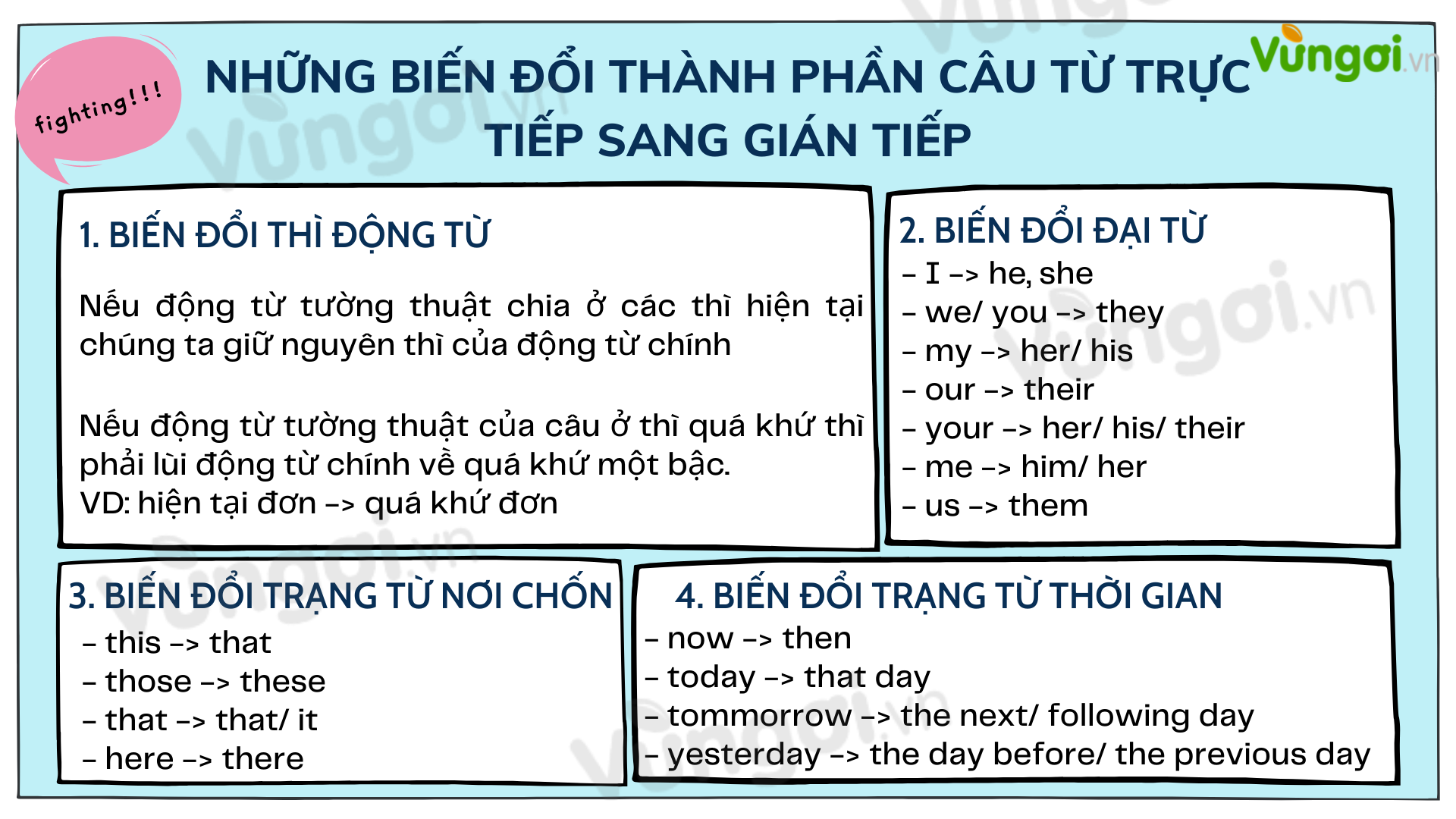Câu tường thuật tiếng Anh (hay còn gọi là câu trực tiếp gián tiếp) là một loại câu được sử dụng để thuật lại một sự việc hay lời nói của ai đó. Nói một cách dễ hiểu hơn, việc sử dụng câu tường thuật là bạn đang chuyển câu trực tiếp sang gián tiếp.
1. Câu tường thuật của câu yêu cầu, đề nghị ai đó làm gì
a. Cấu trúc của câu trực tiếp:
- Câu mệnh lệnh
Ex: “Sit down, please” my teacher said
“Don’t litter in our class”, the teacher said
- Câu cầu khiến với modal verb
Can/ Could/ Will/ Would … + you + V nguyên thể? (Bạn có thể…
Ex:
“Can you see me after class?” Ms Brown asked Tom.
“Could you help for a moment?” Lan asked Nga
b. Cấu trúc của câu gián tiếp
S + told / asked + O + (not) + to V ….
Ví dụ:
- “Can you see me after class?” Ms Brown asked Tom.
=>Ms Brown asked Tom to see her after class.
(Cô Brown yêu cầu Tom ở lại gặp cô ấy sau giờ học.)
- “Could you help for a moment?” Lan asked Nga.
=> Lan asked Nga to help her for a moment.
(Lan nhờ Nga giúp đỡ cô ấy một lúc.)
- “Sit down, please” our teacher said
Our teacher asked us to sit down.
(Giáo viên yêu cầu chúng tôi ngồi xuống)
- “Don’t litter in our class”, the teacher said
The teacher told us not to litter in our class.
(Giáo viên yêu cầu chúng tôi không được vứt rác ra lớp học.)
2. Câu tường thuật của câu khuyên nhủ
a. Cấu trúc câu trực tiếp
- Câu trần thuật với modal verb should/ ought to/ had better
Ex: “You should complete all the homework before going to class” Tuan said to me
- Câu điều kiện loại 2: If I were you, I would + V nguyên thể (nếu tôi là bạn, tôi sẽ…)
Ex: “If I were you, I would spend money on buying a new bike” Nam said to Quang
b. Cấu trúc câu gián tiếp
S + advised + O (not) to V…
Ex:
“You should complete all the homework before going to class” Tuan said to me
=> Tuan advised me to complete all the homework before going to class.
(Tuan khuyên tôi nên hoàn thành tất cả bài tập trước khi đến lớp)
“If I were you, I would spend money on buying a new bike” Nam said to Quang
=> Nam advised Quang to spend money on buying a new bike.
(Nam khuyên Quang nên dung tiền mua một chiếc xe đạp mới)
3. Các cấu trúc câu gián tiếp khác
Khi lời nói gián tiếp là một lời đề nghị, mệnh lệnh, ý định, lời hứa, lời yêu cầu, …động từ tường thuật cùng với động từ nguyên mẫu theo sau nó thường được dùng để chuyển tải nội dung lời nói này. Tùy vào từng trường hợp và ngữ cảnh, ta chọn động từ tường thuật phù hợp
a. Reporting Verb + To-inf …
- agree demand (đòi hỏi) guarantee (bảo đảm)
- hope promise swear (thề)
- threaten (đe dọa) volunteer offer (đưa ra đề nghị)
- refuse consent (bằng lòng) decide
Ex: “I will give you my book if you need it,” said my friend.
→ My friend offered to give me her book if I needed it.
b. Reporting Verb + O + To-inf …
- ask (bảo, yêu cầu) advise (khuyên) command (ra lệnh)
- expect (mong đợi) instruct (hướng dẫn) invite (mời)
- order (ra lệnh) persuade (thuyết phục) recommend (khuyên)
- remind (nhắc nhở) encourage (cổ vũ) tell (bảo)
- urge (thúc giục) warn (cảnh báo) want (muốn, mong muốn)
Ex: “Don’t forget to lock the door,” I said to my sister.
→ I reminded my sister to lock the door.
Ann said: “Come to my place whenever you are free.”
→ Ann invited me to come to her place whenever I was free.
Chú ý:
Khi chuyển câu trực tiếp sang câu gián tiếp, cần biến đổi trạng từ chỉ nơi chốn và thời gian, đại từ theo quy tắc sau:
a. Trạng từ nơi chốn và thời gian
|
Câu trực tiếp |
Câu gián tiếp |
|
This |
That |
|
These |
Those |
|
Here |
There |
|
Now |
Then |
|
Today |
That day |
|
Yesterday |
The day before/ The previous day. |
|
Tomorrow |
The next day/ The following day. |
|
Ago |
Before |
|
Last night |
The night before/ The previous night. |
|
Next week |
The following week/ The week after. |
|
The day before yesterday |
Two days before/ earlier |
b. Đại từ nhân xưng
|
Câu trực tiếp |
Câu gián tiếp |
|
I |
He/ she |
|
We/ you |
They |
|
You (nếu là chủ ngữ) |
They/ I/ he/ she |
|
Me |
Him/ her |
|
Us |
Them |
|
You (nếu là tân ngữ) |
Them/ me/ him/ her |
c. Đại từ sở hữu
|
Câu trực tiếp |
Câu gián tiếp |
|
My |
His/ her |
|
Our |
Their |
|
Your |
Their/ my/ his/ her |
|
Mine |
His/ hers |
|
Ours |
Theirs |
|
Yours |
Theirs/ mine/ his/ hers |
c. Đại từ chỉ định
“This, that” có thể đổi thành “it”
“These, those” có thể đổi thành “that/ them”
Ví dụ:
Mary said: “This is the first time I’ve broken my arm.”
→ Mary said that it was the first time she had broken her arm.
“Give me that!” Mary said to me.
→ Mary told me to give it to her.


